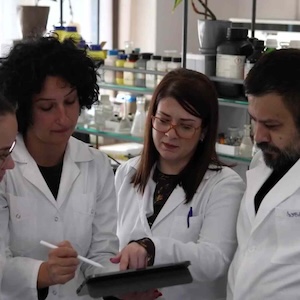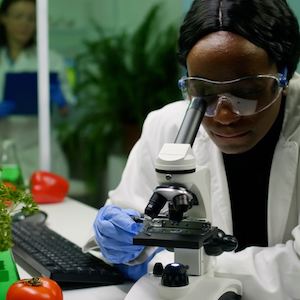Acknowledging the remarkable contributions of women in STEM is vital. Across the ages, these pioneering women have been instrumental in shaping our understanding of the world, from groundbreaking medical advancements to the mysteries of outer space. Their legacies illuminate the path for future generations, underscoring the importance of diversity and innovation in science, technology, engineering, and mathematics.
Below, and via Britannica and other sources, you can celebrate women in STEM by exploring in more depth the stories of the most influential female leaders in science, as well as their contributions to their respective fields, and the profound impact they've had on our lives and the progress of humanity
The Pioneers of Science
Women pioneers in science have changed the way we understand the world around us, as evidenced by work from such female scientists as Marie Curie and Ada Lovelace.
Marie Curie
Perhaps one of the most famous women in science, Marie Curie was the first woman to win a Nobel Prize and the only person to have won in two different scientific fields (physics and chemistry). She was recognized for her research and work on radioactivity in the early 1900s, and she also worked as head of the physics lab at the Sorbonne.
Ada Lovelace
Another influential woman in science from whom we can all take note is Ada Lovelace, who was recognized as the first computer programmer for her work on Charles Babbage's early mechanical general-purpose computer, the Analytics Engine. Although this computer never actually came to fruition, Ada was the first to discover that a computer program could follow a simple series of instructions to complete a complex calculation.
Breakthroughs in Medicine
Thanks to groundbreaking work and research from female scientists like Rosalind Franklin and Tu Youyou, the world of medicine has been forever changed for the better.
Rosalind Franklin
Born in 1920, Rosalind Franklin was best known for her groundbreaking discovery of DNA and RNA, as well as her extensive research on different viruses, coal, and graphite. Without her work, we wouldn't understand molecular structure and many other scientific concepts that we rely on so heavily today.
Tu Youyou
Tu Youyou, Chinese scientist and phytochemist, is best known for her discovery of artemisinin and dihydroartemisinin, both of which have been used for the successful treatment of malaria. Her work and discoveries have undoubtedly saved millions of lives, and she was even awarded the Nobel Peace Prize in physiology/medicine in 2015.
Innovations in Technology and Engineering
Research in technology and engineering has transformed our world. Moreover, women in STEM like Hedy Lemarr and Grace Hopper built the foundation for some of the most critical technologies that we use today.
Hedy Lemarr
Not only was Austrian-born Hedy Lemarr an American film star, but she also co-invented an early version of frequency-hopping spread spectrum communication that was crucial during World War II. That method of communication built the foundation for such groundbreaking technologies as Bluetooth, GPS, and even Wi-Fi.
Grace Hopper
Another noteworthy woman in the STEM fields of technology and engineering is Grace Hopper, a computer scientist and naval officer who developed the first compiler (known as COBOL) in 1952. This invention was responsible for translating high-level computer programming languages into code that could be read by a machine. Grace Hopper pioneered in developing some of the first computer programming languages while also serving in the United States Navy.
Environmental and Earth Sciences
Work in earth sciences and environmentalism has raised awareness to such issues as pollution and deforestation. Initiatives from female scientists like Rachel Carson and Wangari Maathai have made the world a better place.
Rachel Carson
Rachel Carson was an American biologist whose work and writings on environmental pollution spread awareness of the dangers of pollution and its potential impact on the planet. She was perhaps best known for her 1962 book Silent Spring, which has since been credited with advancing the global environmental movement as we know it today.
In addition to her work in environmentalism, Carson also worked as an aquatic biologist and taught at both the Johns Hopkins summer school and the University of Maryland.
Wangari Maathai
For her contributions to sustainable development, democracy, and peace, Wangari Maathai was awarded the Nobel Peace Prize in 2004. This made her the first Black African woman to win a Nobel Prize.
Maathai was best known for being the founder of the Green Belt Movement in 1977, an organization that aimed to combat deforestation and desertification by planting trees. By the early 21st century, it is estimated that this movement led to the planting of around 30 million trees worldwide.
Physics and Astronomy
Groundbreaking work from such physicists and astronomers as Chien-Shiung Wu and Vera Rubin have undoubtedly transformed our understanding of these disciplines.
Chien-Shiung Wu
Chien-Shiung Wu was a leading experimental physicist who worked on the Manhattan Project and conducted what is known as the Wu experiment. This contradicted the hypothetical law of conservation of parity. She was also the first person to confirm Enrico Fermi's beta decay theory.
For her work, she was given the nickname “First Lady of Physics” and conducted a great deal of research on how red blood cells change in cases of sickle-cell anemia.
Vera Rubin
Yet another influential woman in physics and astronomy is Vera Rubin, whose research on the rotation rates of galaxies provided key evidence of the existence of dark matter. In 1993, Rubin was awarded the National Medal of Science by President Clinton. Although she passed away in 2016, her work remains integral to the field of physics today.
Mathematics and Computer Science
Thanks to contributions from female mathematicians and biochemists like Katherine Johnson and Maryam Mizrakhani, we have been able to better understand the world around us — and our place within it.
Katherine Johnson
As a mathematician, Katherine Johnson's work in calculating orbital mechanics was critical to the success of the first and subsequent manned space flights in the United States. Specifically, her calculation and analysis of spacecraft flight paths during her three decades with the space program helped send astronauts to the moon.
Johnson received several awards for her work in the space program, including the 2015 Presidential Medal of Freedom. In 2016, NASA even named the Katherine G. Johnson Computational Research Facility after her. She lived until 2020, where she passed away at the age of 101.
Maryam Mizrakhani
Maryam Mirzakhani was an Iranian mathematician and a professor of mathematics at Stanford University. Her work on the dynamics and geometry of Riemann surfaces and their moduli spaces has been groundbreaking. Mirzakhani was the first woman and the first Iranian to be honored with the Fields Medal, the most prestigious award in mathematics, which she received in 2014.
Her contributions have opened new paths for research in mathematics, significantly advancing the understanding of the symmetry of curved surfaces. Mirzakhani's work is celebrated for its depth, creativity, and potential to further unlock the mysteries of the mathematical universe. Her legacy continues to inspire mathematicians and young women around the world to pursue their interests in mathematics and science.
The Next Generation of Female Scientists
Although we have seen some truly incredible and inspirational female scientists in STEM over the past couple of centuries, it's also important to look toward the future. Currently, there are numerous up-and-coming women in STEM making huge contributions to science, technology, engineering, and mathematics.
Sabrina Gonzalez Pasterski
Born in 1993, Sabrina Gonzalez Pasterski is an American physicist and cosmologist from Chicago who studies high-energy physics. Having earned her Ph.D. from Harvard by the young age of 25, her work on the PSZ Triangle and the discovery of the spin memory effect are among some of her biggest contributions to date. She is also known for her work promoting STEM education for girls in Russia and was recognized in 2018 by the Albert Einstein Foundation as "one of the 100 greatest inventors, artists, scientists, and visionaries of our time."
Gitanjali Rao
In 2020, Gitanjali Rao was named Time’s first-ever ‘Kid of the Year’ for her innovations and work in STEM. As a young inventor, author, and scientist, Rao is perhaps best known for her water lead-level measuring device. However, she has also developed a diagnostic tool that can be used to diagnose prescription opioid addiction, and an AI app that can detect cyberbullying.
Overcoming Barriers: Challenges Faced by Women in Science
Despite all these incredible contributions and breakthroughs, science remains a historically male-dominated field. There are many factors contributing to this fact, including dated gender stereotypes, with STEM fields often being considered ‘masculine.’ This can make it more difficult for women to break the stigma and begin studying/working in STEM-related disciplines, especially in certain cultures.
Combine all of this with the fact that women also have fewer role models in science fields and it's easier to see why STEM disciplines remain dominated by males. This lack of role models is exacerbated by the "broken rung" in the ladder to management. This concept, highlighted by a McKinsey report, refers to the challenges women face at the first step up to manager. For every 100 men promoted, only 87 women are promoted, creating a significant disparity over time.
Also of note, being a woman who also holds other minoritized identities has additional challenges and is an area for growth in the field.
Today, initiatives exist across the globe to begin breaking stigmas and biases surrounding women and STEM from a young age. Funding for female STEM education (including summer STEM camps and after-school learning opportunities for girls) aims to ensure that all students are exposed to science, technology, engineering, and mathematics from a young age.
Finally, there are initiatives across the United States and worldwide to promote the closing of the gender pay gap, which differs by race/ethnicity, not just in STEM, but throughout all industries. This has included presidential memorandums to relaunch the White House equal pay task force, as well as launching a pay transparency initiative.
Learn More Today
There's no denying that the world needs more diversity in scientific research and a greater sense of gender equality in STEM fields. Still, there have also been incredible and inspiring female scientists who have defied the odds and made names for themselves in their respective disciplines. From women in science and engineering to female environmental scientists striving to save the planet, it's safe to say that we can all be inspired by the hard work of these role models.
Interested in forging your own path as a woman in a male-dominated field? The University of Minnesota's College of Continuing & Professional Studies offers a Master of Professional Studies in Applied Sciences Leadership, a graduate-level Leadership for Science Professionals Certificate, and a Master of Biological Sciences degree. Get in touch today to learn more about this and other programs offered at UMN CCAPS.








